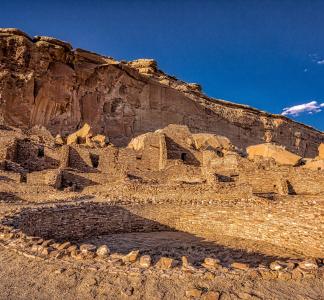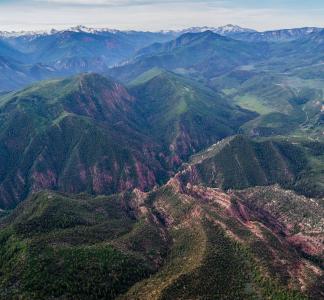3 Southwestern landscapes we can protect from mining and drilling

The Ruby Mountains, part of the Humboldt-Toyabe National Forest in Nevada
Mason Cummings
Places in Nevada and New Mexico include tribal homelands, key wildlife habitat
Across the Southwest, local communities, Tribes, outdoor enthusiasts and environmental organizations are working tirelessly to protect public lands and waters from the long-term harm of mining and oil and gas drilling. Right now, we have a chance to protect three ecologically and culturally significant landscapes from destructive development through protective measures called "mineral withdrawals."
Most public lands managed by the Bureau of Land Management are open to mining and drilling. But a mineral withdrawal prevents new mining or mineral development in a certain area for up to twenty years, helping to safeguard clean water, wildlife habitat, cultural resources and outdoor recreation.
Read on to learn more about the development threats facing vital habitat in Amargosa Valley (Nevada), the Ruby Mountains (Nevada) and the Upper Pecos Watershed (New Mexico).
Amargosa River Valley, Nevada
In the arid landscapes of Nevada’s Amargosa River Valley, water is more than a resource—it is life itself. The Ash Meadows National Wildlife Refuge, located near the eastern edge of Death Valley National Park, is a vital part of the valley’s unique ecosystem and hydrology. This oasis-like complex of wetlands is home to an incredible array of unique desert species, including the critically endangered Devils Hole pupfish, and it comprises part of the ancestral homelands of the Timbisha Shoshone and Southern Paiute tribes.
Unfortunately, this irreplaceable desert ecosystem faces growing threats from mining which could risk the water security of rural communities and their economies. A major concern is the significant amount of water required for mining in a region already struggling with scarcity. In fact, exploratory drilling and potential open-pit mining north of the refuge threaten to puncture the groundwater table, which could irreversibly divert water from the refuge, local communities, and rare and imperiled species.
In response to these threats, a coalition of local leaders, Tribes and conservation advocates are working to protect this unique region with a proposed mineral withdrawal, which would protect about 300,000 acres of public lands around the refuge from mining, for the next 20 years. This withdrawal would ensure the sustainability of this fragile and culturally significant ecosystem and the future of communities in the region.

Ash Meadows National Wildlife Refuge in Nevada
Mason Cummings
Upper Pecos Watershed, New Mexico
The Upper Pecos Watershed has sustained New Mexico’s communities, economy and way of life for generations. The area is a place of deep cultural significance for Indigenous Peoples, including the Pueblos of Jemez and Tesuque, who have long relied on its natural resources for sustenance and ceremony—as well as for traditional Hispanic communities whose acequia-based agriculture (a traditional irrigation system using gravity-fed canals to deliver water from streams and rivers to agricultural fields) has thrived for centuries.
The watershed provides critical water resources that support local communities, farmers, ranchers, businesses and outdoor recreation. It also contains pristine habitat for species like the Rio Grande cutthroat trout.
Sadly, hardrock mining threatens this area that is still recovering from past mining disasters, including a toxic spill in 1991 that killed 90,000 fish and cost $28 million of taxpayer dollars to cleanup. Many fear that mining could have a negative effect on the quality of the headwaters of the Pecos River.
The Pueblos of Jemez and Tesuque, as well as state and local officials, conservation groups and agricultural communities, have been fighting for years to protect this landscape. In April 2024, the Trump administration canceled a proposal would protect around 165,000 acres of public lands from new mining claims and mineral leases for 20 years.

Pecos River in New Mexico
Jim O’Donnell, Amigos Bravos
Ruby Mountains, Nevada
Often referred to as "Nevada's Swiss Alps," the Ruby Mountains are renowned for their exceptional recreational opportunities, including hunting, fishing, hiking and birdwatching, drawing outdoor enthusiasts from all over the world every year.
The area is also the ancestral homeland of the Te-Moak Tribe of the Western Shoshone Indians of Nevada and provides critical habitat for wildlife, including the Himalayan snowcock, the threatened Lahontan cutthroat trout and one of Nevada’s largest mule deer herds.
Despite their ecological and cultural significance, the Rubies face threats from potential oil and gas development. Because of this, Tribes, conservationists, sportsmen and local communities are advocating for the area’s protection. In April 2024, the Trump administration canceled a proposal to ban oil and gas development on an area of about 264,000 acres in the Rubies for the next 20 years.

Ruby Mountains in Nevada
Mason Cummings
Great news: New oil and gas leasing banned from public lands around Chaco Canyon
Mobilus In Mobili/Flickr
Colorado’s Thompson Divide protected from new drilling for next 20 years!
Ecoflight
Arctic Refuge rollbacks, other Trump actions, prioritize drilling and mining interests over communities
Fredrik Norrsell



